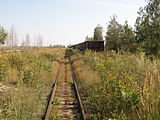Gusevskoye Peat Railway
History
Gusevskoye peat railway emerged in the 1920s, in the area Gus-Khrustalny District, in a settlement named Gus-Khrustalny in 1931 became a town. The railway had a maximum length of about 100 kilometres (62 mi) at their peak. Gusevskoye railway was built for hauling peat and workers and operates year-round with several pairs of trains a day. At present only 25 kilometres (16 mi) of the railway is operational, current operations include passenger traffic (workers-tourists) and freight traffic, transportation of peat. A peat briquette factory was built and put into operation in 2010 in a settlement named Gusevskiy. A peat briquette factory was built and put into operation in 2011 in a settlement named Mezinovskiy. About 2011 half of the railroad was dismantled. Formed two separate railway network.
Current status
There was two separated railways, operated by different companies.
- Guseevskiy – westbound.
- Mezinovskiy – northbound.
Transportation of peat to the briquette factory is ongoing.
Rolling stock
Locomotives


Locomotive Depot – Mezinovskoye:
- TU7 – № 2999, 3310, 2087, 3028, 3311
- TU6D – № 0023
- TU6A – № 1663
- ESU2A – № 249, 721, 997, 994
- ESU1 – № 277 (Snow blower)
- TD-5U Pioneer
- GMD4 rail lorry (to the museum in 2013)
Engine Shed - Gusevskoye:
- TU4 – № 2303, 1547
- ESU2A – № 1024, 987
- Draisine - PD1 – № 764
Railroad car
- Flatcar
- Tank car
- Snowplow
- Tank car - fire train
- Passenger car
- Side-tipping wagons
- Open wagon for peat
- Hopper car to transport track ballast
Work trains
Gallery
See also
References and sources
- ^ Gusevskoye peat railway
- ^ "Briquette factory 2010". Archived from the original on 2013-07-13. Retrieved 2013-07-12.
- ^ "Briquette factory 2011". Archived from the original on 2019-04-01. Retrieved 2013-07-12.
- ^ "GMD4 rail lorry 2013". Archived from the original on 2014-05-17. Retrieved 2013-07-12.
External links
- Official Website «ENBIMA Group» (Gusevskiy)
- Official Website «Vladimir-Peat» (Mezinovskiy) (in Russian)
- Photo - project «Steam Engine» (in Russian)
- «The site of the railroad» S. Bolashenko (in Russian)




